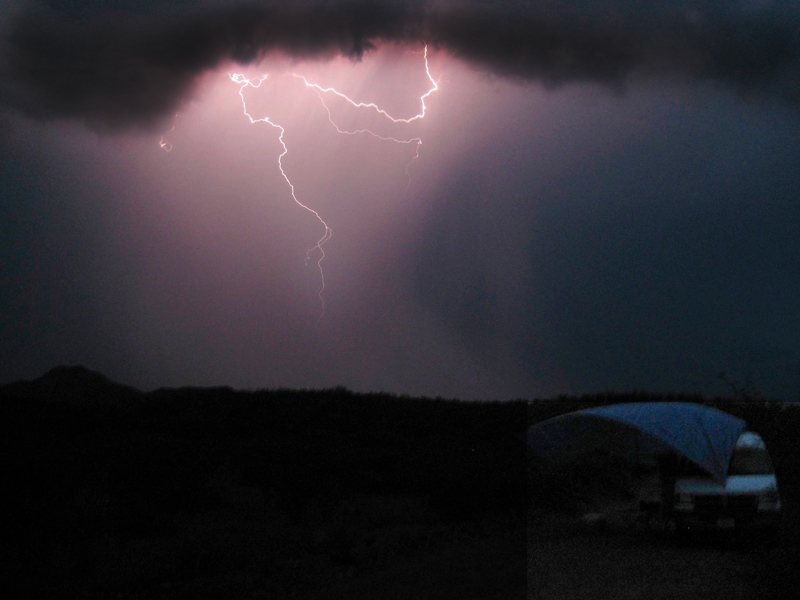Wow it’s been a few weeks since my last post, and I’m a bit embarrassed having let it go so long. What have I been up to? Not a whole not. No impressive collecting trips, no new species or discoveries. Actually I’ve been sitting at a microscope dissecting genitalia or databasing parasitic flies. I’ll have to do a followup post to delve into those a bit more…
But for now, here is a picture form last August. I was standing on an open stretch of Chihuahuan desert right outside of Douglas Arizona; a whopping one mile from the Mexican border. I arrived that evening with my collecting colleague, microlepidopterist Peter Jump, and we had just set up camp as the roll of thunder grew close. Aside from the extinct cinder-cones surrounding us and an occasional illegal immigrant, we were the only (and highest) thing around for miles. But the lightening was too hard to resist, I need a picture! But I didn’t have a cable release, nor a tripod, or even a good camera. So what to do… I chose the genius option of standing outside for 40 minutes with my Canon point-and-shoot. I missed 99% of every shot I took, while with every passing minute the lightening grew closer. Finally, I stumbled upon this decent image. The storm ended up being brief, we huddle in the car (that you can just make out in the picture) while the lightening approached and it drizzled on us for an hour then moved on. Collecting that night was impressive. There were so many moths in the trap that everything had gotten beaten to bits. I managed to rescue a handful of good specimens, but lesson learned for next time.


Dazzling. I’ve found my best blacklighting also when a whopper of a storm is brewing – don’t know what it is about that weather that makes the bugs so active.
I’ve noticed the odd night here or there where the moths in the trap seemed to be exceptionally ratty, and I’ve wondered at the cause and how to prevent it. The fact that it wasn’t happening every night ruled out the trap itself as the ultimate cause, though if, as you say, it’s due to too many individuals inside at once then I suppose the trap is partly to blame. How to get around it? Larger trap? Two traps together? Turn it off halfway through the night? (But what about the late-night flyers?)
I think there are a handful of factors, first and foremost being the percentage of strong flying moths (like Sphingidae) or beetles. But that seems pretty obvious, 40 flapping sphingids in the trap turns it into a vortex, or beetles run around destroying things.
I think it also depends on the killing agent you are using, wind, and how well the trap is sealed. On the most humid of humid nights acetate seems to start failing, where cyanide in the trap would be ideal.
I’m headed to Southern TX in a few weeks and I’ve made some preparations – I’ve built screens that will fit around my traps to keep out the big stuff, and I’ve prepared to have three jars of acetate per trap. Hopefully, that will do it!! The alternative is to completely swap out the traps two or three times over the course of the night, which is something I know people do (sigh).
Back in the day, we used BOTH ethyl acetate and potassium cyanide, because acetate was good for the smaller moths and cyanide provided a faster knock-out of the heavier, destructive, tromping beetles. Moist, wet weather definitely plays a part; you certainly want your trap dry for the equipment, both killing agents to work effectively, and the quality of the catch. We also used a timer for the UV light (both AC and DC) – one of those plug-in varieties that allow you to set the hours of when something should be on and off. This was mainly due to the fact that we had up to 20 traps across 3 counties to set and collect once a week for 4 months every summer for over 10 years. I suspect the timer could easily be adapted to collect at certain or multiple time periods in any given night, depending on your goals.
ps – Chris, what’s this southernfriedscience that I see in your address? If I go to your usual WordPress, Seabrooke and your reply do not show.
That’s a ton of traps! What was this survey work for?
And- I have moved my entire blog to the southern fried science network, the old wordpress blog will only exist as an archive and no updates will be made. So please change your links to the new page, thanks!
Not being a collector (except of photographs), I live trap so the acetate/cyanide wouldn’t be something I’d need to think about. But I can see how beetles and heavy moths could really stir things up. I hadn’t really paid attention to their numbers in the catch on those nights versus others. (I can’t even imagine 40 sphingids in the trap at once! A busy sphinx night for me might be a dozen). Screens are an interesting thought. I wonder how many smaller moths you’d lose by having something they could bump into or land on.
I’m not a collector anymore, either, Seabrooke. Do you have any sample pics of the plates in your new book?
Seabrooke, I found a couple pics of your book plates online. Nice! I like the natural poses over pinned and stretched moth specimens. Good job.